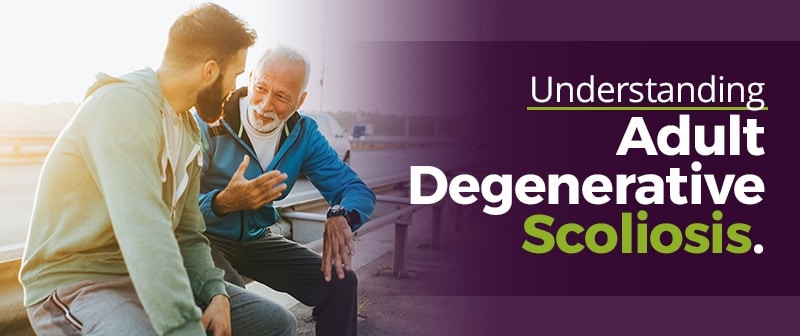
Adult degenerative scoliosis is a form of the condition marked by degenerative changes to the discs of the spine; it’s also referred to as ‘adult de novo scoliosis’, meaning onset has occurred specifically during adulthood. Understanding the signs of adult degenerative scoliosis is important because if left untreated, its progression can affect the body in multiple ways.
While scoliosis is primarily known as an adolescent disorder, there are instances where adults are diagnosed with the condition, and the rate of scoliosis does actually increase with age.
If you’re an adult experiencing unexplained neck, back, leg, or nerve pain, scoliosis could be to blame. There are two main forms of adult scoliosis: adult idiopathic scoliosis and adult degenerative or ‘de novo’ scoliosis.
Adult idiopathic scoliosis involves cases of adolescents with scoliosis that went untreated and progressed into adulthood. In these instances, it’s likely that the condition didn’t produce any noticeable symptoms during adolescence. Often, it’s not until a patient reaches skeletal maturity that scoliosis-related pain starts to become evident, causing them to seek a diagnosis.
Adolescents with scoliosis left untreated for years can develop degeneration within their scoliosis, even though that’s not a classic form of adult-onset scoliosis that’s degenerative. This means that within the curvature itself, there are signs of degeneration or osteoarthritis.

These types of osteoarthritis and degeneration of the spine occur when the spine is not properly aligned and there’s an abnormal gravity or weight-bearing effect on the tissues of the spine, which include the discs, ligaments, nerves, and bones.
There’s also what’s called adult degenerative, or ‘de novo’, scoliosis. The difference with this form is that the scoliosis has developed during adulthood and wasn’t carried forward from adolescence. These cases are due to degenerative changes to the spinal discs.
The spinal discs have multiple purposes: acting as the spine’s shock absorbers, holding the vertebrae of the spine together, and facilitating the spine’s mobility. When problems with the spinal discs occur, the spine can shift and become misaligned.

When there’s an asymmetrical spinal alignment, it can cause the spine to go through an asymmetrical aging process. This type of premature degeneration is measurable on an X-ray or MRI.
The more degeneration a person has, the more likely they are to have pain associated with that degeneration. The pain will likely be localized to the area of the person’s scoliosis or degeneration. If the issues are in the middle back, that’s where the pain will be felt; if the issues are in the lower back, lower back pain will occur.
As nerves can also be affected, pain can radiate to different parts of the body, but the most classic symptom of adult degenerative scoliosis is stiffness. The stiffness is felt in movement and in the spine’s range of motion.
When it comes to early signs of adult degenerative scoliosis, the most common is generalized stiffness, which can lead to localized and generalized pain.
The stiffness and pain can then progress to radiating pain and weakness in the area related to the scoliosis.
For example, if the scoliosis is located in the spine’s lumbar section (lower back), pain can radiate into the legs; if located in the thoracic spine (middle back), pain can radiate into the ribs, hands, and arms.
As adult degenerative scoliosis worsens over time, it starts to affect sagittal alignment, meaning the spine’s healthy side curve. As degenerative scoliosis progresses, a person’s overall posture can really start to shift. There can be a reduction in the lumbar lordosis (healthy lower-back curve) and an exaggeration of the thoracic kyphosis (healthy upper-back outward curve).

What that posture shift can look like is ribs severely out of alignment relative to the hips, and in the later stage, the body can start to lean forward to the point where it becomes impossible to extend and look upwards.
If left untreated, the pain and stiffness associated with the condition will only worsen, along with the asymmetry of the spine.
When a patient experiences the type of stiffness characteristic of adult degenerative scoliosis, the lack of movement and stiffness in the affected area initiates a cyclical effect.
The less motion a spine goes through, the more degeneration it’s likely to experience, because motion of the spine is the primary way that nutrients go in and out of the soft tissues, discs, ligaments, nerves, and bone.
The more the spine degenerates, the more asymmetrical it becomes, and this enacts what’s known as ‘Wolff’s Law of Bone Transformation’.
Wolff’s law of bone transformation states that in a healthy person, bone grows and transforms in response to forces placed upon it. However, once a bone that bears weight is out of normal alignment or doesn’t achieve symmetrical weight-bearing, it enters into a degenerative phase.
Once that degenerative phase has been entered, efforts have to be made to treat the patient’s condition, or they’ll be faced with two outcomes:
The stiffer an area of the spine is, the more degeneration and asymmetrical changes it will face, and this leads to more problems with the spine’s soft tissues. At some point, these issues will have to be dealt with by treating the condition proactively.
When it comes to treating adult degenerative scoliosis, the best treatment approach is one that actually addresses the spine’s symmetry. Traditional forms of treatment that focus solely on pain management do nothing to address the underlying structural issue.
Pain medications and injections can provide patients with relief from some of the condition’s symptoms, but they’re not addressing the curvature itself. Even recommendations for physical therapy to help strengthen the spine fall short, as the asymmetrical process is being strengthened along with the spine.

If treatment includes reducing the curvature, the cyclical nature of the condition can be stopped. If left untreated, it can result in spinal collapse on the coronal (frontal) and sagittal (left and right side) plane.
An effective treatment plan for adult degenerative scoliosis has to address the asymmetrical spine in order to slow down the degenerative process, restore normal motion, and to break that cyclical pattern of progression.
Here at the CLEAR Scoliosis Institute, we remind our patients that it’s never too late to start treatment. For patients who come to us in the advanced stages of degeneration, we simply adapt and adjust our CLEAR treatment protocols to address the patient’s condition.
In a sense, every one of our treatment plans are modified as we take a proactive and customized approach with each and every patient. I will say, however, that treatment started earlier is an easier path that offers a higher likelihood of success.
When it comes to treating adult degenerative scoliosis here at CLEAR, our doctors are certified in scoliosis-specific chiropractic treatment. Through a series of chiropractic adjustments, physical therapy, and exercise, we address the structural issue of the curvature so we can break that cycle of degeneration, asymmetry, and nutrient loss.
While it’s possible to reverse some degeneration of discs, ligaments, and muscles, the same can’t be said of bone degeneration; once that occurs, it’s a permanent state. This is why it’s so beneficial to seek treatment for adult degenerative scoliosis early on.
While some traditional approaches to treating adult degenerative scoliosis focus on pain management and physical therapy recommendations, there are two main problems with this approach.
Firstly, medications and injections that take away the pain are only addressing a symptom of the condition, but not the condition’s underlying cause and the condition itself. Secondly, while physical therapy can be helpful in strengthening the spine, the asymmetrical process is strengthened along with it, doing nothing to actually correct the asymmetry that’s feeding the degenerative cycle.
Here at the CLEAR Scoliosis Institute, we focus on treating our patients and their condition, not just their symptoms. By doing this, we can reach our ultimate goal of improving our patients’ quality of life through pain reduction, restoring balance and posture, and proactively preventing future issues.
The author’s views are his or her own and may not reflect the views of CLEAR Scoliosis Institute.

CLEAR provides a unique and innovative way of understanding scoliosis. Sign up to receive facts and information you won’t find anywhere else.
